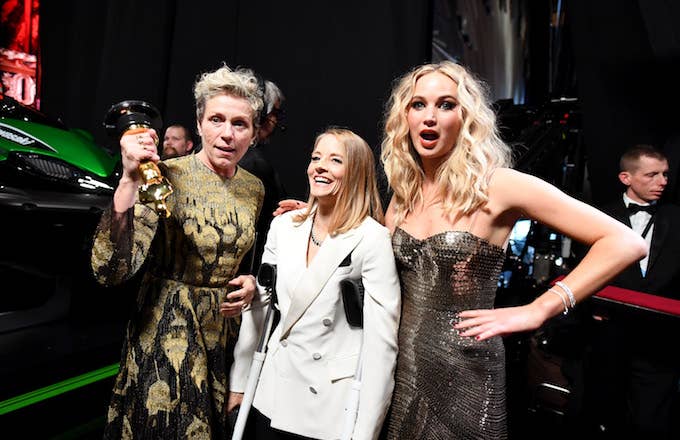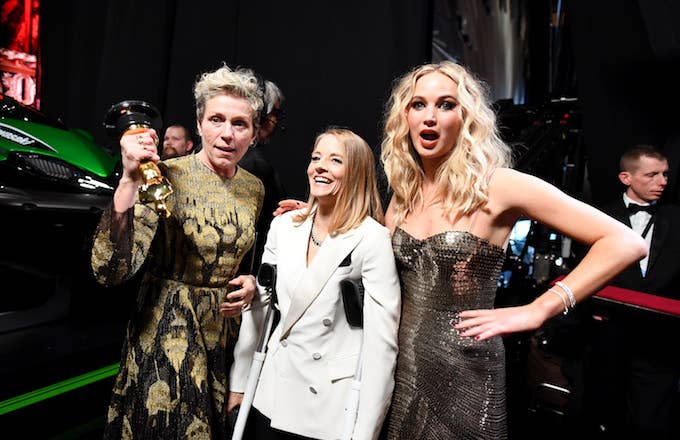
Back in October, you probably wouldn’t have been wrong to assume that the initial accusations against Harvey Weinstein’s despicable behavior toward women in the entertainment industry would have remained just that, merely accusations. For many—especially women—it’s easy to feel cynical about whether these so-called cultural moments will actually have any change.
But seeing how those initial accusations have ballooned into a wave of sexual assault accusations against abusers in all different industries, and how those have culminated in Time’s Up and the #MeToo movement can make even the most cynical feminist a tiny bit hopeful. That's not to say there isn't still a mountain of work still to do—but if we can at least talk openly about the problem, then we're on the right path.
Those movements are supported by a continuing effort to release more and more research about gender inequality in the entertainment industry—although it’s a phenomenon that exists in virtually all industries, we already pay so much attention to Hollywood to begin with that a change there is likely to influence a change elsewhere. Today, the New York Film Academy (NYFA) released some statistics and research on gender in film from the past 10 years (from 2007 to 2017), a review of more than 40 sources and scholarly studies. The review was released in the form of a series of infographics.
“With all that’s happening in the film industry, the New York Film Academy hopes to contribute what we can to the conversation with this infographic. It can be used as a reference and an educational tool to raise further awareness and inspire leaders within the entertainment industry, and beyond,” NYFA Chair of Documentary Andrea Swift said. “It is an accessible way to interact with key information to support the movement to reach 50/50 by 2020.”
Some of the most striking findings from the infographic include how women are portrayed onscreen in the top 900 films from 2007-2016. In those films, only 30.5 percent of speaking characters are women; at the same time, in 2017, men portrayed 4,900 characters while women portrayed just over 2,000.
But it’s not enough to just appear in movies, it’s also about what women do once they get on the screen. In the top 900 films between 2007 and 2016, a quarter of the women that appeared in the movies wore revealing clothes (only 5.7 percent of men wore the same kind of clothes). Plus, only 12 percent of all movies featured a balanced cast in which half of the characters are female. That’s all despite the fact that women purchased half of all movie tickets sold in the U.S. in 2017.
When it comes to seeing women onscreen, if we’re really committed to action instead of just talking the big talk, the data supports hiring more women both behind and in front of the camera. NYFA’s infographic shows there is a 5.4 percent increase in female characters onscreen when a woman is in the director’s chair; similarly, there is a 10.7 percent increase when a female screenwriter is attached to the project. It follows, then, that the more women who are involved in the decision-making aspects of a movie, the more women will be represented onscreen, too. Wonder Woman, which was both directed by and obviously starring women, became the fifth biggest superhero movie in history at the domestic box office in 2017 (that’s pre-Black Panther days, but Panther was also a beacon of representation behind the camera).
As it stands, there is a lot of work to do when it comes to representation behind the scenes. The discrepancies are stark: looking at the 250 top grossing films of 2017, 89 percent of them had male directors while just 11 percent were helmed by women. The most striking comparison is in cinematography: 96 percent were male, with only 4 percent female. That’s why Dee Rees’ Oscar-nominated work with Mudbound was so historic.
Finally, while it’s true that film stars make a bucketload of money, as a whole, men are still making many more bucketloads than women. According to a Forbes 2017 list, the top 10 highest-paid actors made a combined $488.5 million dollars, versus a comparatively measly $172.5 million dollars being paid out to the top 10 highest-paid actresses. That contrast was made evident on just one set, when Mark Wahlberg made $1.5 million dollars for All The Money in the World reshoots while his co-star, Michelle Williams, made just under $1,000. Their salaries were also out of whack to begin with, never mind the reshoots. (Wahlberg eventually donated the entirety of his salary to Time’s Up.)
Check out the full infographic series below.


